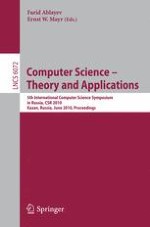2010 | Buch
Computer Science – Theory and Applications
5th International Computer Science Symposium in Russia, CSR 2010, Kazan, Russia, June 16-20, 2010. Proceedings
herausgegeben von: Farid Ablayev, Ernst W. Mayr
Verlag: Springer Berlin Heidelberg
Buchreihe : Lecture Notes in Computer Science
